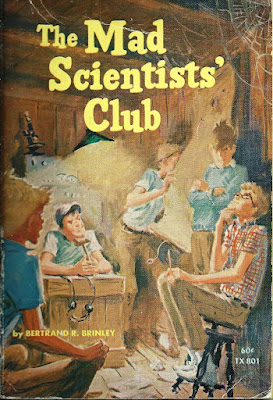Book Review: 'The Mad Scientists' Club' by Bertrand R. Brinley
5 / 5 StarsIf you're a Baby Boomer, then you surely are familiar with some, or perhaps all, of the four books in The Mad Scientists' Club franchise.
The author, Bertrand Brinley (1917-1994) was a public relations staffer with the US government, the Martin Company, and later, for Bell Labs.
The franchise started with the appearance of 'The Strange Sea Monster of Strawberry Lake' in the magazine Boy's Life in September 1961, with additional stories appearing in the magazine in 1962 and 1964. In 1965 the stories were assembled into 'The Mad Scientists' Club', a paperback from Scholastic Book Services, the juggernaut of Young Adult print media. The copy of the book in my possession is the fourth edition, from 1968.
That same year Brinley published a sequel, 'The New Adventures of the Mad Scientists' Club'. A third volume in the franchise, 'The Big Kerplop', saw print in 1974. An unpublished manuscript, 'The Big Chunk of Ice', was published posthumously in 2005.
Paperback and hardback editions of all the books in the franchise can be had from your usual online retailers.
As for Club, it consists of: Jeff Crocker (President), Henry Mulligan (Vice President and Chief of Research), Dinky Poore, Freddy Muldoon, Homer Snodgrass, Mortimer Dalrymple, and Charlie Finckledinck, the first-person narrator. The Scientists live in Mammoth Lake, a generic small town, and while their ages never are disclosed, they likely are in junior high (or perhaps the freshman year of high school).
The Club is devoted to using science to create good-natured hijinks in Mammoth Falls, which often leaves the town's blowhard mayor, Alonzo Scragg (and quite a few other adults), looking foolish. In the stories in 'The Mad Scientists' Club', our heroes craft a 'sea monster' that causes quite a commotion in a local lake; leverage a dinosaur egg into a media event; investigate rumors of a lost treasure secreted in a Civil War monument; employ a department store mannikin to disrupt the town's Founders Day ceremony; compete in a hot-air balloon race; and arrange for an old house to be 'haunted'.
The seventh and final story in the book involves the Club in a 'grown-up' drama centering on the rescue of a downed pilot, and as such, the Club's foray into the world of adulthood. It shows the author's deft touch as a writer.
For me, re-reading 'The Mad Scientists' Club' is an exercise in nostalgia and I'm sure it is that way for many people. A similarly nostalgic overview of the book is available at this blog.
I finished the book with some regret, as the Scholastic catalog stopped carrying the title long ago, and I doubt anyone under 20 is familiar with The Mad Scientists' franchise.
I'd like to believe that despite portraying the adventures of a group of straight, white, young males, who wear Chuck Taylor / Pro Keds sneakers, blue jeans, and tee shirts, and who live in an all-white town in Middle America, the Mad Scientists' Club will appeal to all kids. But I think there is a very low likelihood that this novel will get any traction with the modern-day school district staff and book publicists who decide the reading lists for middle school students.
So treasure the days gone by, the Baby Boom era, and 'The Mad Scientists' Club', as they recede into the mists of time..........
































No comments:
Post a Comment